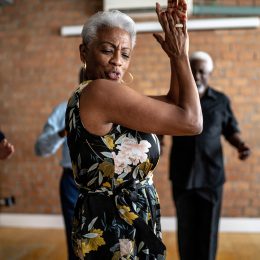Living with Adult Children: 6 Things to Consider Before You Move In
Sharing a household has its perks—especially if you adopt these tips for a smooth transition.

If you’re a fan of home shows on TV, you might think the only new housing trends are open-concept floor plans and kitchen islands the size of Borneo. But actually, there’s something even bigger going on: It’s called “doubling up.”
According to a new Generations United study, between 2011 and 2021, the number of multigenerational households in the United States grew by a whopping 271 percent. That means nearly 26 percent of American adults—more than one in four—are living with other generations of their family.
Some of them are “boomerang” children, returning to the nest after college, job loss, or divorce. But a growing share of adults living in somebody else’s household are parents moving in with their adult children.
In fact, that group doubled in size between 1995 and 2017, according to 2018 Pew Research. The trend really revved up during the Great Recession, from 2007 to 2009, and it grew even more during the COVID-19 pandemic.
Sound too close for comfort? Maybe not. For most of those doubled up (or tripled up) families, the arrangement seems to be working out just fine, with some 98 percent reporting that their household is running smoothly and happily.
And though they may have been brought together by need, they often stay together by choice. More than 70 percent of those currently living in a multigenerational household say they plan to continue living together long-term.
“Human beings are designed to live in extended families,” says John Graham, professor emeritus of business at the University of California, Irvine and co-author of All in the Family: A Practical Guide to Successful Multigenerational Living.
“Spending time with a small number of people in our family group is built into our psyche, and that didn’t change until marketers invented the term ‘nuclear family’ in the 1950s,” he says. “Multigenerational living doesn’t always work, but when it does, it works quite well. Everybody is healthier, socially and mentally.”
It’s not so much a new trend as a throwback to earlier times. “In 1940, nearly 80 percent of elderly widows lived with their children,” Graham says. But by 2010, that had dropped to 18 percent, he adds.
Today, however, lots of factors are bringing that old-fashioned arrangement back into vogue, driven by everything from rising health care costs to shrinking pensions. “The solution for the future,” says Graham, “is going to be home care provided by extended families.”
Maybe it’s a solution that could work for you and your family. Here’s what to consider before you make the leap, plus essential tips to navigate this new living arrangement successfully.
3 Benefits of Multigenerational Living
There are lots of good reasons for moving in with your adult children, but here are three of the biggest ones.
Benefit #1: You Can Save Money
Thinking about selling the house and moving to a retirement community? It would be wise to think again. In addition to the hefty entrance fees, you’ll also be faced with about $30,000 in annual fees, depending on where you live.
If you have some health issues and need a bit of help with your activities, you might consider an assisted-living facility. But that also comes with a hefty price tag: The average cost in the United States is $51,600 per year, per person. The average retirement nest egg, though, is just $107,000, which may not last very long in a pricey retirement community.
“Often, budgetary realities may influence families’ living arrangements,” says Lenard Kaye, Ph.D., director of the University of Maine Center on Aging, in Bangor. “It can just make good financial sense to pool your resources with someone else.”
And the financial benefits can go both ways—after all, how great is it for your busy adult children to have a built-in babysitter?
Benefit #2: You Can Deepen Family Ties
Sure, you had some rocky moments when your kids were teenagers, but they’re all grown up now. Chances are, you’ve developed a more equal relationship with them and enjoy spending time together. This can be a chance to get to know one another better and develop a special sense of closeness.
Plus, it’s great for the grandchildren. One new study from the University of Michigan found that children who grew up in a multigenerational household had higher levels of cognitive functioning as adults. “It can be a rich environment for cultural conversations,” says Ellen Flaherty, director of the Dartmouth-Hitchcock Center on Aging, in Lebanon, New Hampshire.
Benefit #3: You Can Live Healthier—and Longer
Doubling up can help family members reduce stress and lessen loneliness—big factors driving both mental and physical illness.
“Loneliness and social isolation lead to depression and other health issues,” Flaherty says. “Preempting that sense of loneliness with the support of family members can be a wonderful thing.” Plus, a recent study published in SSM-Population Health showed that healthy people living in a two-generation household live longer than those living on their own.
While you’re considering the pros, keep an eye on the cons too. “Togetherness can be great,” says Flaherty, “but there can be issues with privacy. And there will always be some amount of conflict. They key is not to just throw in the towel. Constant communication is essential.”
3 Must-Dos for Making It Work
If you’re thinking of moving in with your adult children, consider these tips from the pros.
Subscribe to our newsletter
It's quick and easy. You could be one of the 13 million people who are eligible.
Already a member? Click to discover our 15,000+ participating locations.
Follow Us
Must-Do #1: Talk Through All the Details Ahead of Time
You don’t need to go to a lawyer and draft an official contract, but it’s a good idea to get everybody’s expectations down on paper.
“If you don’t have open, honest discussions up front, there’s a high risk that this arrangement won’t work out in the long-run,” Kaye says. “Make sure you have a meeting of the minds from the start so that once you enter into an agreement, everybody can respect it.”
Points to consider:
- Who pays for what expenses?
- How will you handle entertaining friends?
- What are the household rules—and are any of them nonnegotiable?
If possible, suggests Kaye, it may be a good idea to do a trial run of, say, six months before committing to a permanent living arrangement with another person. And be open to revising the household rules periodically. See what works and what doesn’t.
Must-Do #2: Set Boundaries
If there are kids in the household, don’t overstep. “As grandparent, you’re not the child’s parent,” Flaherty says. “After all, parenting styles differ by generation, and you may approach issues like discipline differently than your adult children do. That can be challenging.”
Another caveat: Respect privacy. Living quarters with a separate bathroom and entrance are ideal. But no matter what size the home, it’s important to honor everybody’s personal space.
Must-Do #3: Spread Your Wings
As much as you love your family, be sure to develop and nurture relationships outside of your family too. “Everyone needs to have some quality time on their own and with others,” Kaye says. “Make an effort to be with friends and relatives with similar interests. The multigenerational living relationship shouldn’t necessarily monopolize your whole life. After all, most of us will benefit from a robust social network, since it is rare for life to completely revolve around just the people living under the same roof.”
Check Your SilverSneakers Eligibility Instantly
SilverSneakers members can go to thousands of gyms and fitness locations across the nation, plus take SilverSneakers LIVE online classes that are designed for seniors of all levels. If you have a Medicare plan, it may include SilverSneakers—at no additional cost. Check your eligibility instantly here.
Not eligible for SilverSneakers? You can still get 200+ free SilverSneakers On-Demand videos and stay in touch with us by creating your online account.





